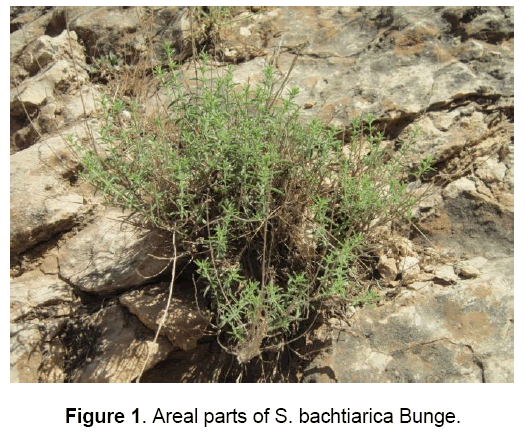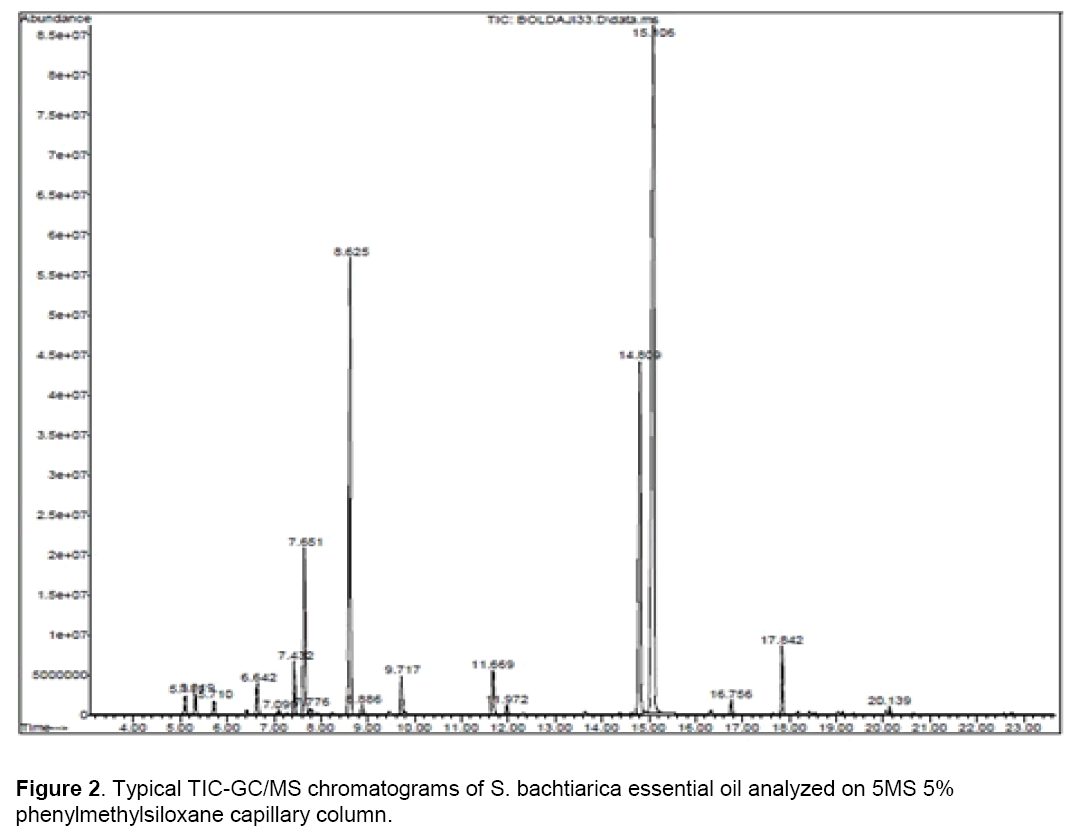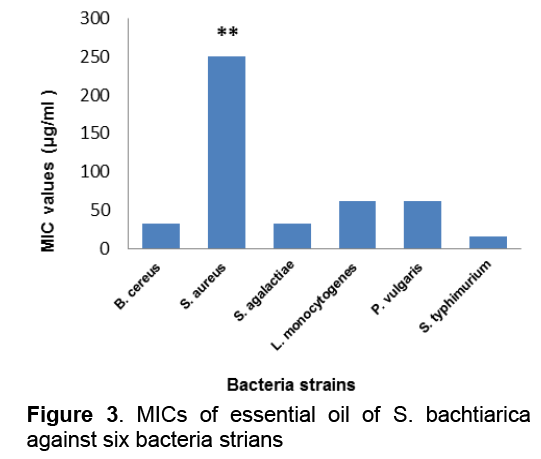Bioactivity of Essential Oil of Bakhtiari Savory (Lamiaceae)
E. Solaymani Babadi, A. Ghasemi Pirbalouti, H. Nourafcan, B. Hamedi
1Miyaneh Branch, Islamic Azad University, College of Agriculture, Department of Horticulture Science, Miyaneh, Iran;
2Shahrekord Branch, Islamic Azad University, Department of Medicinal Plants, Shahrekord, Iran;
3Medicinal Plants Program, College of Natural Sciences, University of Massachusetts, Amherst, MA, 01003, USA.
- Corresponding Author:
- Tel: +1 (413) 545 2570
E-mail: aghasemipir@psis.umass.edu
Abstract
Satureja bachtiarica Bunge (local name: Marzeh-e-Koohi) is an endemic specie plant that widely distributed in the Central Zagros Mountains, Iran. This study was designed to examine the chemical composition and antibacterial activity of the essential oil of Satureja bachtiarica Bunge (Lamiacae). The essential oil of Bakhtiari savoury was analyzed by GC/MS, and also tested for antibacterial activity of the essential oil was tested by agar disc diffusion and serial dilations assay against four positive-Gram (Bacillus cereus, Staphylococcus aureus, Streptococcus agalactiae and Listeria monocytogenes) and two negative-Gram (Proteus vulgaris and Salmonella typhimurium) bacteria strains. The results showed that the major components of the oil were carvacrol (44.8%), ?-terpinen (18.7%) and thymol (14.95%). The essential oil of S. bachtiarica has strong antibacterial against bacteria strains, especially S. agalactiae, S. typhimurium and P. vulgaris. MICs of the essential oil against B. cereus = 31.25 μg/ml, S. aureus = 250 μg/ml, S. agalactiae = 31.25 μg/ml, L. monocytogenes = 62.5 μg/ml, P. vulgaris = 62.5 μg/ml and S. typhimurium = 16 μg/ml were determined. Finally, the essential oil of S. bachtiarica aerial parts could be suitable for application in the food industry and pharmaceutical.
https://linktr.ee/marmaris1 https://www.divephotoguide.com/user/marmaris1/ https://artmight.com/user/profile/2408931 https://allmyfaves.com/marmaris1 https://www.fimfiction.net/user/628252/marmaris https://www.drupalgovcon.org/user/568666 https://www.roleplaygateway.com/member/marmaris1/ https://www.kickstarter.com/profile/825997479/about https://tapas.io/sam659667 https://seedandspark.com/user/marmaris1 https://starity.hu/profil/386591-marmaris1/ https://www.informationweek.com/profile.asp https://nootheme.com/forums/users/marmaris1/ https://app.roll20.net/users/12308972/marmaris1-m https://www.360cities.net/profile/sam659667 https://fileforum.com/profile/marmaris1 https://wordpress.org/support/users/marmaris1/ https://www.hebergementweb.org/members/marmaris1.539143/ https://forum.cs-cart.com/u/marmaris1/ https://www.tntxtruck.com/User-Profile/UserId/12208 https://calis.delfi.lv/blogs/posts/205779-linkler/lietotajs/310821-marmaris1/ https://profile.ameba.jp/ameba/marmaris1/ https://www.avianwaves.com/User-Profile/userId/184770 https://engine.eatsleepride.com/rider/marmaris1 https://keymander.iogear.com/profile/53051/marmaris1 https://www.mifare.net/support/forum/users/marmaris1/ https://inkbunny.net/marmaris1?&success=Profile+settings+saved. https://www.diggerslist.com/64e0c4fad170b/about https://research.openhumans.org/member/me/ http://bluerevolutioncrowdfunding.crowdfundhq.com/users/marmaris1 https://www.cakeresume.com/me/marmaris1 https://educatorpages.com/site/marrmaris1/pages/about-me? https://gotartwork.com/Profile/marmaris1-marmaris1/253385/ https://www.facer.io/user/OGfo7VWrhR https://able2know.org/user/marmaris1/ https://www.techrum.vn/members/marmaris1.230749/#about http://foxsheets.statfoxsports.com/UserProfile/tabid/57/userId/145739/Default.aspx http://riosabeloco.com/User-Profile/userId/196075 http://phillipsservices.net/UserProfile/tabid/43/userId/245691/Default.aspx http://www.ramsa.ma/UserProfile/tabid/42/userId/962725/Default.aspx http://krachelart.com/UserProfile/tabid/43/userId/1242308/Default.aspx http://kedcorp.org/UserProfile/tabid/42/userId/72907/Default.aspx http://atlantabackflowtesting.com/UserProfile/tabid/43/userId/561626/Default.aspx https://www.intensedebate.com/people/marmaris12 https://rosalind.info/users/marmaris1/ https://wordpress.com/me https://photozou.jp/user/top/3342211
Keywords
Bakhtiari savoury, thymol, carvacrol, antibacterial activity.
Abbreviation
MIC Minimum inhabitation concentration, GC gas chromatography, MS Mass spectrometry.
1. Introduction
The genus Satureja (Lamiaceae) constitutes about 200 species of herbs and shrubs, widely distributed in Mediterranean area, Asia and boreal America [1]. Twelve species of this genus are growing wild in western and northern parts of Iran [2]. Some of the species of Satureja for example S. hortensis L. are of economic importance since they have been used as culinary herbs, flavoring agents in perfumery and cosmetics. The leaves, flowers and stems are used for herbal tea and, in traditional medicine, to treat various ailments, such as cramps, muscle pains, nausea, indigestion, diarrhea and infectious diseases [3]. It has been reported that there are marked differences between and within the subspecies of Satureja essential oil composition [4]. The essential oils isolated from various species of Satureja have biological properties such as anti-bacterial [5-7], anti-fungal [8-9], anti-viral [8,10], anti-oxidant [11], antispasmodic, anti-diarrheal, anti-nociceptive and anti-inflammatory [12], anti-HIV-1 [8] and immunomodulatory effects [13].
Satureja bachtiarica Bunge (local name: Marzeh-e-Koohi) is an endemic plant that widely distributed in the Central Zagros Mountains, Iran [14]. In the folk medicine, this plant has been used as analgesic and antiseptic by Bakhtiari and Chaharmahali tribes of Iran [15]. The major components of S. bachtiarica were p-cymene, carvacrol and thymol [16].
The aim of this study was to evaluate the in vitro antibacterial activity and phytochemical properties of essential oil of Bakhtiari savoury collected from Central Zagros Mountains.
2. Materials and Methods
Plant material
The aerial parts (500 g) of wild population of S. bachtiarica Bunge were collected from Boldaji (latitude. 31° 58´ N, longitude. 51° 06´ E, altitude.2400 m above sea level), Chaharmahal va Bakhtiari province, Iran at June 2011. The sample of the plant (Figure 1) was identified by regional floras and authors with floristic and taxonomic references [2], and voucher specimen was deposited at the Herbarium of Research Centre of Agricultural of Chaharmahal va Bakhtiari province, Iran (No. CHB-1999).
Sample preparation
Dried plant material were powered (100 g) and subjected to hydro-distillation (1000 ml distillated water) for 3 h using a Clevenger- type apparatus according to the method recommended in British pharmacopoeia [17]. Samples were dried with anhydrous sodium sulphate and kept in amber vials at 4 °C prior to use.
Antibacterial test
Four positive-Gram (Bacillus cereus, Staphylococcus aureus, Streptococcus agalactiae and Listeria monocytogenes) and two negative-Gram (Proteus vulgaris and Salmonella typhimurium) bacterial strains were clinical isolates obtained from Food Microbiology Laboratory, Veterinary Medicine Faculty, Islamic Azad University, Iran, and identified using conventional morphological as well as biochemical tests. Stock cultures of bacteria were kept in 20% glycerol PBS (phosphate buffered saline) at -70 °C. Active cultures were generated by inoculating 100 μl of the thawed microbial stock suspensions into 5ml nutrient broth (Merck, Germany) followed by overnight incubation at 37 °C. An initial bacterial suspension containing 107 CFU/ml was made from the flask broth culture. Subsequent dilutions were made from the above suspension, which were then used in tests. The density of bacteria culture required for the test was adjusted to 1.0 McFarland standards, (1.0 x 107 CFU/ml) measured using the spectrophotometer (Eppendorf, AG, Germany). Absorbance at 600 nm of known bacterial densities was determined to obtain a standard calibration curve. Subsequent dilutions were made from the above suspension, which were then used in tests.
The disc diffusion method of Iennette (1985) was used with some modification to determinate rate of inhibition growth of bacteria by plant essential oil [18]. BHI agar (Merck, Germany) was used to prepare the culture medium and autoclaved at 121 °C for 15 min. The plates (8-cm diameter) were prepared with 10 ml agar inoculated with 1 ml of each bacterial suspension. Sterile paper discs (6 mm in diameter) were impregnated with 60 μl of dilutions of known essential oil concentrations (2-500 μg/disc) and incubated at 35 °C for 18 h. Bacterial growth inhibition was determined as the diameter of the inhibition zones around the discs (mm). The growth inhibition diameter was an average of three measurements, taken at three different directions. All tests were performed in triplicate.
The MIC values were evaluated using the broth serial dilution method according to standard methods [19]. Bacterial strains were cultured overnight at 37 °C in Muller Hinton Broth (MHB, Oxoid). Stock solution of the essential oil was prepared in 5.0% (v/v) dimethyl sulfoxide (DMSO). Dilution series, using MHB, were prepared from 8 to 500 mg/ml. After incubation at 37 °C for 24 h, the microorganism growth inhibition was evaluated by measuring absorbance at 630 nm, using a spectrophotometer. Experiments were performed in triplicate but at three different times.
Gas chromatography/mass spectrometry (GC/MS) analysis
The essential oil was analyzed using an Agilent 7890 A gas chromatograph (Agilent Technologies, Palo Alto, CA, USA) with a HP-5MS 5% phenylmethylsiloxane capillary column (30.00 m x 0.25 mm, 0.25 μm film thickness). Oven temperature was kept at 60 °C for 4 min initially, and then raised at the rate of 4 °C/min to 260 °C. Injector and detector temperatures were set at 290 and 300 °C, respectively. Helium was used as carrier gas at a flow rate of 0.8 ml/min, and 0.5 μl samples were injected manually in the splitless mode. Peaks area percents were used for obtaining quantitative data. The GC/MS analyses were carried out using an Agilent 5975 C (Agilent Technologies, Palo Alto, CA, USA) with a HP-5MS 5% phenylmethylsiloxane capillary column (30.00 m x 0.25 mm, 0.25 μm). Mass range was from m/z 50–550 amu. Identification of oil components was accomplished based on comparison of their retention times with those of authentic standards and by comparison of their mass spectral fragmentation patterns (WILLEY/ChemStation data system) [20].
Statistical analyses
The data was statistically analyzed using one-way ANOVA by the program SPSS version 17.0.
3. Results and Discussion
Essential oil yield and chemical composition
The yellow oil of S. bachtiarica was obtained by hydro-distillation in the yield of 1.78% based on dry weight. The chemical constituents identified by GC/MS, the results concerning the qualitative and quantitative analysis of the essential oil are presented in Figure 2 and Table 1. Eighteen compounds were identified, representing 97% of the essential oil, in which the major components of the essential oil of S. bachtiarica were carvacrol (44.8%), γ-terpinen (18.7%) and thymol (14.95%). The main constituent groups in S. bachtiarica essential oil were monoterpenes and sesquiterpenes (Table 1). In 2000, Sefidkon & Jamzad [16] reported that the main components of the essential oil of S. bachtiarica were thymol (44.5%), γ-terpinene (23.9%), p-cymene (7.3%), β-caryophyllene (5.3%) and borneol (4.2%). The results of other study showed that the main components of the essential oil of S. bachtiarica were carvacrol (49.3%), p-cymene (12.7%) and trans-α-bergamotene (5.8%) for Fars population and, carvacrol (66.5%), p-cymene (15.2%) and linalool (4.6%) for Yazd population [21].
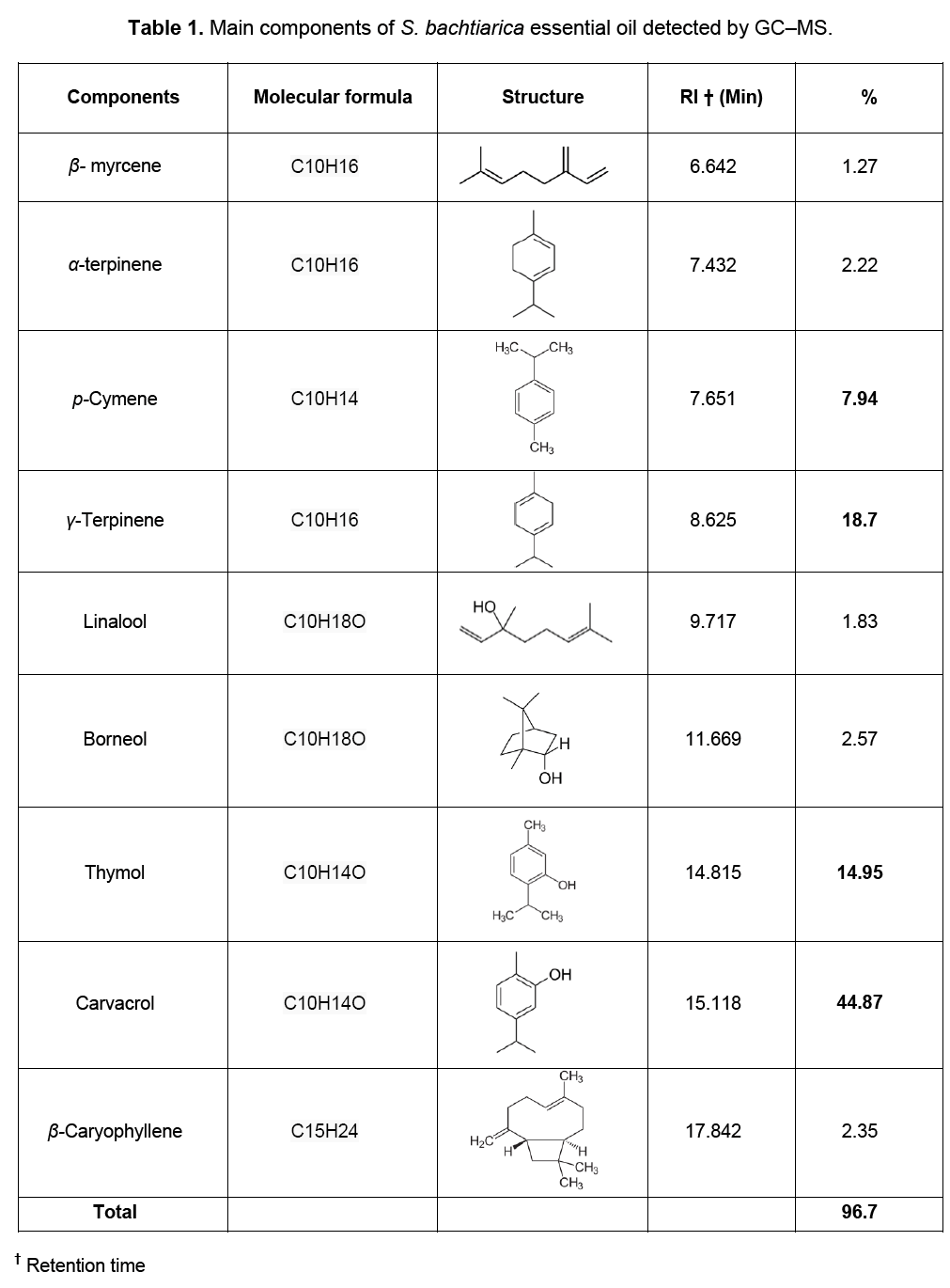
Antibacterial test
Four of the six bacteria used (B. cereus, L. monocytogenes, S. agalactiae and S. aureus) were Gram-positive and two (P. vulgaris and Salmonella typhimurium) were Gram-negative. There was a significant variation in the antibacterial activities (DIZ values) of essential oil (Table 2). For B. cereus, the DIZ values of different concentrations were between 9.3 mm and 30.0 mm. For S. aureus, concentrations of S. bachtiarica essential oil (8-500 μg) exhibited inhibitory activity. For L. monocytogenes, all concentrations had inhibitory activity. For S. agalactiae, all concentrations of S. bachtiarica essential oil exhibited high inhibitory activity. Of the two Gram-negative bacteria tested, for P. vulgaris, the DIZ values varied from 9.3 mm to 30.7 mm. Various concentrations of S. bachtiarica essential oil exhibited inhibitory activity against S. typhimurium. In general, a total of S. bachtiarica essential oil showed relatively high inhibitory activities against the six food-borne pathogenic bacteria tested (Table 2). Percentage inhibition increased with the concentration. At concentrations of 16 and 32 μg, bacterial were moderately inhibited, while at concentrations of 250 and 500 μg, the crude essential oil completely inhibited the growth of the bacteria strains.
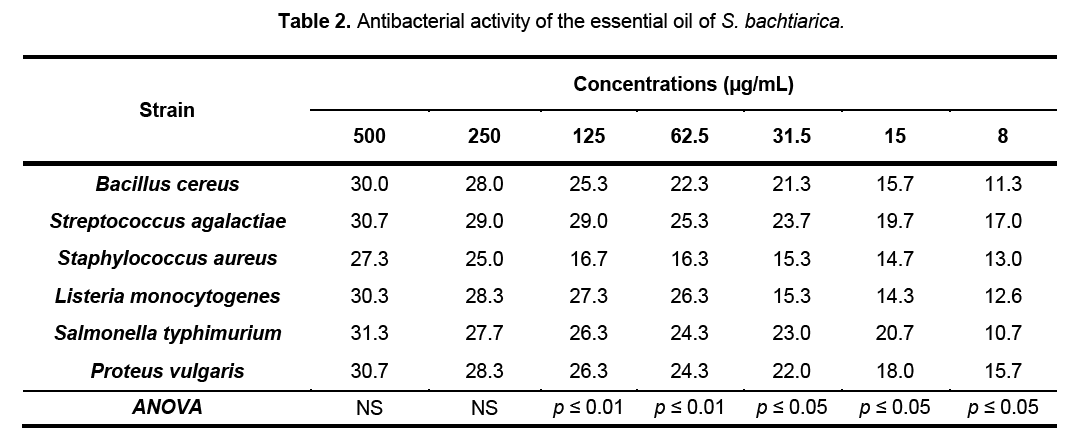
The MIC values of the essential oil against bacteria are presented in Figure 3. Of the Gram-negative bacteria tested, S. typhimurium was the most sensitive. Of the Gram-positive bacteria tested, S. aureus was the most resistant of the tested organisms.
The result of identification of phenolic compounds using HPLC showed that the major components of S. bachtiarica were carvacrol and thymol [22]. Shan et al. (2007) reported that a total of 46 spice and herb extracts from different regions contained high levels of phenolics and exhibited antibacterial activity against foodborne pathogens [23]. They suggested that there were highly positive relationships (R2=0.73–0.93) between antibacterial activities and phenolic content of the tested extracts against each bacterium. Some studies claim that the phenolic compounds present in spices and herbs might also play a major role in their antimicrobial effects [24].
The phenolic compounds, such as thymol and carvacrol, are widely reported to possess high levels of antimicrobial activity [24]. Many aromatic plants essential oil for example S. bachtiarica contained high levels of phenolics and exhibited antimicrobial activity. The results of this study showed that carvacrol (45%) and thymol (15%), which are the main components of S. bachtiarica essential oil, have been considered as biocidal, resulting in bacterial membrane perturbations that lead to leakage of intracellular ATP and potassium ions and ultimately cell death [25-27].
Ghasemi Pirbalouti et al. (2010) reported that the strongest activity (MIC=39 μg/ml) was shown by essential oil of S. bachtiarica against B. cereus and C. albicans. Also, their results showed that essential oils were significantly more active against Gram-positive bacteria and yeast (MICs ranging from 39 to 100 μg/ml) than against Gram-negative bacteria (MICs >250 μg/ml) [5].
4. Conclusions
GC-MS analysis showed that that major compounds in S. bachtiarica essential oil were carvacrol, γ-terpinen and thymol. In the present study we demonstrated, the potent antibacterial activity of S. bachtiarica against food-borne pathogens strains, which justifies the large use of this plant in traditional medicine. However, essential oil of S. bachtiarica is accessible and with optimization of the concentration can be used in food and food
Acknowledgements
The authors gratefully acknowledge Miyaneh Branch, Islamic Azad University for financial support of this research .
References
- Cantino PD, Harley RM and Wagstaff SJ. (1992). Genera of Labiatae: Status and Classification. In R.M. Harley & T. Reynolds (Eds.), Advances in Labiatae Science. Kew: Royal Botanical Gardens, pp 511-22.
- Rechinger KH. (1982). Flora Iranica, Akademische Druck und Verlagsanstalt, Graz, Austria.
- Gulluce M, Sokmen M, Daferera D, Agar G, Ozkan H, and Kartal N. (2003). In vitro antibacterial, antifungal, and antioxidant activities of the essential oil and methanol extracts of herbal parts and callus cultures of Satureja hortensis L. J. Agric. Food. Chem. 51: 3958-65.
- Slavkovska V, Jancic R, Bojovic S, Milosavljevic S, and Djokovic D. (2001). Variability of essential oils of Satureja montana L. and Satureja kitaibelii wierzb. Ex Heuff. from the central part of the Balkan peninsula. Phytochemistry. 57: 71-76.
- Ghasemi Pirbalouti A, Jahanbazi P, Enteshari S, Malekpoor F, and Hamedi B. (2010). Antimicrobial activity of some of the Iranian medicinal plants. Archiv Biol Sci. 62: 633-42.
- Ciani M, Menghini L, Mariani F, Pagiotti R, Menghini A, and Fatichenti F. (2000). Antimicrobial properties of essential oil of Satureja montana L. on pathogenic and spoilage yeasts. Biotech Lett. 22: 1007-10.
- Dorman HJD, and Deans SJ. (2000). Antimicrobial agents from plants: antibacterial activity of plant volatile oils. J. Appl Microbiol. 88: 308–16.
- Yamasaki K, Nakano M, Kawahata T, Mori H, Otake T, Ueba N, Oishi I, Inami R, Yamane M, Nadamura M, Murata H, and Nakanishi T. (1998). Anti-HIV-1 activity of herbs in Labiatae. Biol. Pharma Bull. 21: 829-33.
- Sokovic M, Tzakou O, and Pitarokili D. (2002). Couladis M. Antifungal activities of selected aromatic plants growing wild in Greece. Food/Nahrung. 46: 317-20.
- Abad MJ, Bermejo P, Gonzales E, Iglesias I, Irurzun A, and Carrasco L. (1999). Antiviral activity of Bolivian plant extracts. Gen Pharmacol. 32: 499-503.
- Radonic A, and Milos M. (2003). Chemical composition and in vitro evaluation of antioxidant effect of free volatile compounds from Satureja montana L. Free Radical Res. 37: 673-79.
- Hajhashemi V, Sadraei H, Ghannadi AR, and Mohseni M. (2000). Antispasmodic and anti-diarrhoeal effect of Satureja hortensis L. essential oil. J. Ethnopharmacol. 71: 187-92.
- Ghasemi Pirbalouti A, Pirali E, Pishkar GH, Jalali SMA, Reyesi M, Jafarian Dehkordi M, and Hamedi B (2011) The essential oils of some medicinal plants on the immune system and growth of rainbow trout (Oncorhynchus mykiss). J. Herbal Drugs. 2: 149-155.
- Jamzad Z. (1994). A new species of the genus Satureja (Labiatae) from Iran. Iranian J Botany. 6: 215-18 (In Persian).
- Ghasemi Pirbalouti A. (2009). Medicinal plants used in Chaharmahal and Bakhtyari districts, Iran. Herba Polon. 55: 69-75.
- Sefidkon F, and Jamzad Z. (2000). Essential oil of Satureja bachtiarica Bunge. J Essent Oil Res. 12: 545-46.
- British Pharmacopoeia. (1988). British Pharmacopoeia. London: HMSO.
- Iennette EH. (1985). Manual of clinical microbiology. American Association for Microbiology, Washington, DC, USA, 1985.
- NCCLS/CLSI - National Committee for Clinical Laboratory Standards (2003). Methods for dilution antimicrobial susceptibility tests for bacteria that grow aerobically. In: Approved standard M7-A6, 6th edition. Wayne, PA, USA.
- Adams RP. (2001). Identification of Essential Oil Components by Gas Chromatography⁄Quadrupole Mass Spectroscopy. Illinois: Allured Publishing Corporation, Carol Stream, UAS.
- Sefidkon F, Jamzad Z, and Barazandeh MM. (2005). Essential oil of Satureja bachtiarica Bunge, a potential source of Carvacrol. Iranian J Med Aromatic Plant. 20: 425-39 (In Persian).
- Ghasemi Pirbalouti A, Hamedi B, and Malekpoor F. (2012). Antibacterial activity of some folklore medicinal plants used by Bakhtiari tribal in Southwest Iran. J Med Plant Res. 6: 675-79.
- Shan B, Cai YZ, Brooks JD, and Corke H. (2007). The in vitro antibacterial activity of dietary spice and medicinal herb extracts. Int J Food Microbiol. 117: 112-19.
- Hara-Kudo Y, Kobayashi A, Sugita-Konishi Y, and Kondo K. (2004). Antibacterial activity of plants used in cooking for aroma and taste. J Food Protect. 67: 2820-24.
- Juven BJ, Kanner J, Schued F, and Weisslowicz H. (1994). Factors that interact with the antibacterial action of thyme essential oil and its active constituents. J Appl Bacteriol. 76: 626-31.
- Helander IM, Alakomi HL, Latva-Kala K, Mattila-Sandholm T, Pol I, Smid EJ, Gorris LGM, and Von Wright A. (1998). Characterization of the action of selected essential oil components on Gram-negative bacteria. J Agric Food Chem. 46: 3590-95.
- Ultee A, Kets EPW, and Smid EJ. (1999). Mechanisms of action of carvacrol on the food-borne pathogen Bacillus cereus. Appl Environ Microbiol. 65: 4606-10.

Open Access Journals
- Aquaculture & Veterinary Science
- Chemistry & Chemical Sciences
- Clinical Sciences
- Engineering
- General Science
- Genetics & Molecular Biology
- Health Care & Nursing
- Immunology & Microbiology
- Materials Science
- Mathematics & Physics
- Medical Sciences
- Neurology & Psychiatry
- Oncology & Cancer Science
- Pharmaceutical Sciences
